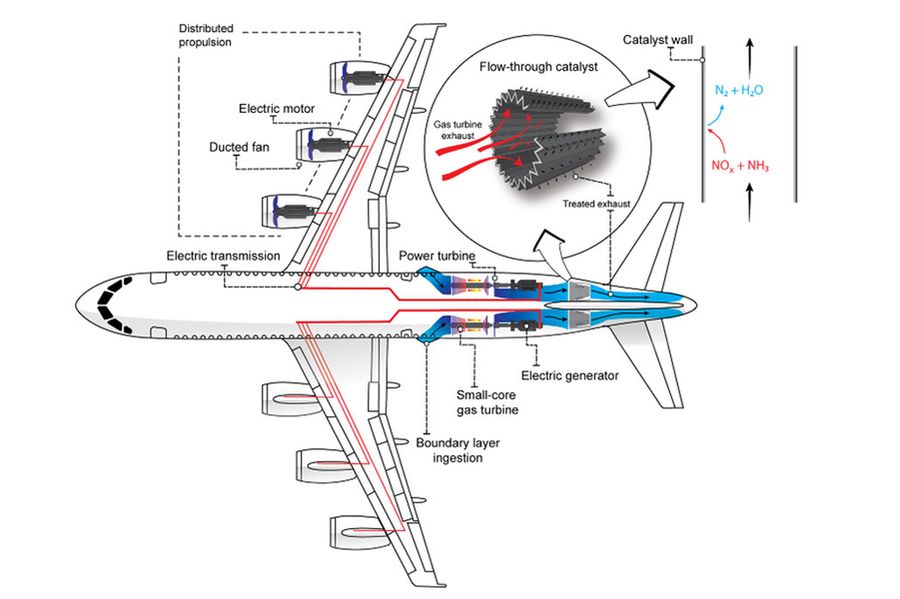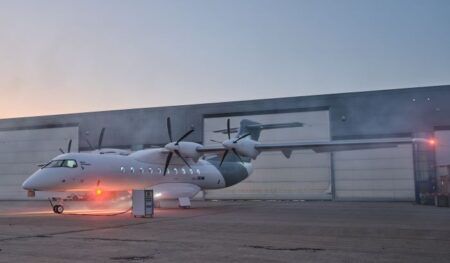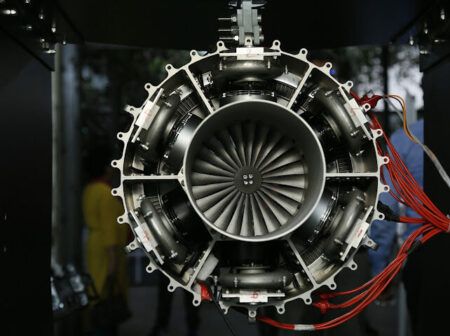Researchers from MIT have developed a concept for aircraft propulsion that would incorporate the same kind of selective catalytic reduction technology diesel trucks and cars use and could eliminate 95% of aviation’s NOx emissions, reducing the number of associated early deaths it causes by 92%.
At cruising altitude, aircraft emit a steady stream of nitrogen oxides into the atmosphere, where the chemicals can linger to produce ozone and fine particulates. Nitrogen oxides, or NOx, are a major source of air pollution and have been associated with asthma, respiratory disease, and cardiovascular disorders.
Research has shown that the generation of these chemicals due to global aviation results in 16,000 premature deaths each year.
The MIT concept is inspired by emissions-control systems used in ground transportation vehicles. Many heavy-duty diesel trucks today house postcombustion emissions-control systems to reduce the NOx generated by engines. The researchers now propose a similar design for aviation, with an electric twist.
In the new hybrid-electric, or “turbo-electric,” design, an aircraft’s source of power is a conventional gas turbine, but it can be integrated within the plane’s cargo hold. Rather than directly powering propellers or fans, the gas turbine drives a generator, also in the hold, to produce electricity, which then electrically powers the aircraft’s wing-mounted, electrically driven propellers or fans.
The emissions produced by the gas turbine would be fed into an emissions-control system, broadly similar to those in diesel vehicles, which would clean the exhaust before ejecting it into the atmosphere.
Steven Barrett, professor of aeronautics and astronautics at MIT said, “This would still be a tremendous engineering challenge, but there aren’t fundamental physics limitations.
“If you want to get to a net-zero aviation sector, this is a potential way of solving the air pollution part of it, which is significant, and in a way that’s technologically quite viable.”
The details of the design, including analyses of its potential fuel cost and health impacts, are published today in the journal Energy and Environmental Science.
A semi-electrified plan
The seeds for the team’s hybrid-electric plane grew out of Barrett and his team’s work in investigating the Volkswagen diesel emissions scandal. In 2015, environmental regulators discovered that the car manufacturer had been intentionally manipulating diesel engines to activate onboard emissions-control systems only during lab testing, such that they appeared to meet NOx emissions standards but in fact emitted up to 40 times more NOx in real-world driving conditions.
As he looked into the health impacts of the emissions cheat, Barrett also became familiar with diesel vehicles’ emissions-control systems in general. Around the same time, he was also looking into the possibility of engineering large, all-electric aircraft.
“The research that’s been done in the last few years shows you could probably electrify smaller aircraft, but for big aircraft, it won’t happen anytime soon without pretty major breakthroughs in battery technology,” Barrett said.
“So I thought, maybe we can take the electric propulsion part from electric aircraft, and the gas turbines that have been around for a long time and are super reliable and very efficient, and combine that with the emissions-control technology that’s used in automotive and ground power, to at least enable semielectrified planes.”
Flying with zero impact
Before airplane electrification had been seriously considered, it might have been possible to implement a concept such as this, for example as an add-on to the back of jet engines. But this design, Barrett said, would have “killed any stream of thrust” that a jet engine would produce, effectively grounding the design.
Barrett’s concept gets around this limitation by separating the thrust-producing propellers or fans from the power-generating gas turbine. The propellers or fans would instead be directly powered by an electric generator, which in turn would be powered by the gas turbine. The exhaust from the gas turbine would be fed into an emissions-control system, which could be folded up, accordion-style, in the plane’s cargo hold — completely isolated from the thrust-producing propellers.

He envisions the bulk of the hybrid-electric system — gas turbine, electric generator, and emissions control system — would fit within the belly of a plane, where there can be ample space in many commercial aircraft.
In their new paper, the researchers calculate that if such a hybrid-electric system were implemented on a Boeing 737 or Airbus A320-like aircraft, the extra weight would require about 0.6% more fuel to fly the plane.
“This would be many, many times more feasible than what has been proposed for all-electric aircraft,” Barrett said. “This design would add some hundreds of kilograms to a plane, as opposed to adding many tons of batteries, which would be over a magnitude of extra weight.”
The researchers also calculated the emissions that would be produced by a large aircraft, with and without an emissions control system, and found that the hybrid-electric design would eliminate 95% of NOx emissions
If this system were rolled out across all aircraft around the world, they further estimate that 92% of pollution-related deaths due to aviation would be avoided. They arrived at this estimate by using a global model to map the flow of aviation emissions through the atmosphere, and calculated how much various populations around the world would be exposed to these emissions. They then converted these exposures to mortalities, or estimates of the number of people who would die as a result of exposure to aviation emissions.
The team is now working on designs for a “zero-impact” airplane that flies without emitting NOx and other chemicals like climate-altering carbon dioxide.
“We need to get to essentially zero net-climate impacts and zero deaths from air pollution,” Barrett says. “This current design would effectively eliminate aviation’s air pollution problem. We’re now working on the climate impact part of it.”





